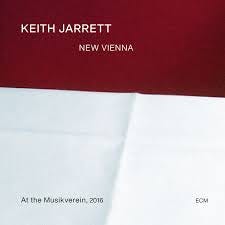On the Occasion of Keith Jarrett's Recent Solo Piano Concert Recording
Is there such a thing as too much?
Last month Keith Jarrett celebrated his 80th birthday. The pianist has been sidelined by a series of strokes since 2018, but his primary label, ECM, has continued to release meticulously recorded live projects, some with his “Standards” trio and some in the format that he pioneered in the early 1970s – entirely improvised concert-length solo performances.
You might have heard one of these – the 1975 The Koln Concert. Jarrett’s commercial breakthrough, it came during the early phase of his solo inquiries, just a few years after his groundbreaking first solo studio recording, Facing You. To understand why Jarrett is revered, start with Facing You, which represents a new chapter in the history of solo jazz piano.
Shortly after the milestone birthday, ECM brought out another previously unreleased solo concert: New Vienna, recorded at the Golden Hall of the Musikverein in 2016. It’s titled this way because it follows an earlier release, the 1991 Vienna Concert captured at the Vienna State Opera. That one is considered among Jarrett’s deepest and most transifixing excursions, an inquiry into shifting, melancholic drone tonalities and textural sustains. Jarrett once described it as “the language of the flame itself.”
New Vienna is different. It begins with piano salad – a spry, many-tempos-at-once jumble that finds Jarrett side-eying Thelonious Monk then Cecil Taylor then Errol Garner then Carla Bley, while making little effort to connect those dots. The second “movement,” Part II, unfolds as a melodic study, a landscape built from single notes and short melodic clusters. The third section begins in the basement of the keyboard, with an arabesque figure that, in classic Jarrett fashion, morphs as it moves into other registers.
Jarrett “frames” the inventions on New Vienna with silences, creating distinct tracks. This is a change from his previous approach: On Koln and the earlier Vienna and many other solo concerts, part of the thrill involves following the ways his thinking evolved over time – an act of spontaneous composition Miles Davis described as playing “from nothing.” Sometimes on Koln and other ‘70s solo concerts, Jarrett rattles through an old fashioned gospel keys-pounding phrase for minutes on end, introducing new interior voices and cadence variations before abruptly swerving off that road to find something else.
And maybe Jarrett wouldn’t find a suitable something else right away. The listener heard him casting about, reaching into the ether for an undefined thing. He had many divining techniques, and he trusted them – repeating single notes and octaves until their resonances changed, scampering through scales and wide-interval arpeggios in various tonalities to “reset” the landscape, seeking some sort of connective bridge to bring him to the next singable thing. Or blurry torrent of notes.
That stuff, the connective journeys between “peaks,” is an element of Jarrett’s searching that remains breathtaking generally, and a specific reason to listen, more than once, to well-known concerts like Bremen-Lausanne. The grasping into air, the pushing forward without a map to plateau midway up the mountain, from which he could survey next possibilities. These searchings have an element of the heroic, not least because he’s a guy on a stage and there’s an audience waiting to hear where he lands (or how he stumbles). His pursuit sometimes arrives in the realm of a “song,” and sometimes its defiantly atonal opposite.
To create this music, Jarrett could not be destination driven. He was not working in the manner of a determined novelist, training his attention on a single plot arc, pulling a single thread. Instead, he was alive to many possible arcs all at once, all within the reach of his formidible – and, crucially, not genre-bound – technique. He understood the sacrifices inherent in this type of real-time search, knew that dead air was a distinct possibility. He was capable of conjuring a delicate, impossibly beautiful rhapsody from thin air, and understood that to find another one, he had to be willing to disrupt it or discard it entirely. His process was both impulsive and exactingly methodical; he created extended linear narratives with non-linear tools.
Sometimes, as is evident in parts of this 1972 concert, those searching-and-not-finding passages exude a kind of hypnotic energy.
That’s one of several apparently unauthorized recordings on YouTube from the early ‘70s. All of the ones I’ve heard have been transportive experiences. There are similarities between them, but they’re not cut from a template. The ones recorded before Koln offer a chance to trace Jarrett’s evolution as both improvisor and editor, when he’s more willing to hunker down in a vamp for a while, or venture fully into New Orleans-style blues, or improvise over progressions that emulate the pathways of Tin Pan Alley standards.
It's telling that ECM, no doubt in consulation with Jarrett, has leaned on later solo works. Maybe Jarrett thinks the earlier ones, which are listed in chronological order on this website, are somehow the “prehistory” of his solo piano concerts, lacking the sculptural contours he brought to the stage later in the ‘70s?
Those who know Bremen-Lausanne might enjoy this crisp recording of the concert Jarrett played two days later, at the Pori Jazz Festival in Finland. Check how, after three minutes of a surging groove, he gently pulls the tempo into a slow reverie – and how that becomes a platform for intricate single-note lines and meditative chordal fantasies.
**
New Vienna is plenty interesting, a justifiable addition to a discography that numbers more than 80 releases. (I counted over 30 solo titles). Still, listening to it, I kept thinking about performances like Pori, which showcase a wild, irreverent aspect of Keith Jarrett’s musical personality; that document feels more electric than the sometimes airless New Vienna. That got me wondering about an inevitable “legacy management” question: Is there a saturation point for Jarrett solo? His journeys are never less than interesting, but do too many iterations wind up diluting appreciation for Jarrett’s singular gifts? I’ve not heard every one of the more than 30 solo ECM releases, but have listened to some of the venerated ones – like Bremen-Lausanne – over and over again. New chills every time.
Of course not every performance catches the lightning in the bottle. But given the rigors and unpredictable nature of Jarrett’s solo approach, perhaps every one of them should be available to future generations with surgically enhanced listening skills? Some record executives might argue that the current solo Jarrett titles offer a reasonably complete portrait of a singular artist doing a very difficult thing. Thankfully, that is not the approach taken by ECM: The possibility that somewhere in the multi-decade archive of Keith Jarrett solo piano concerts sits a tape of thundering radical originality is reason enough for the label to keep searching, and for listeners to pay attention whenever the next Jarrett recording surfaces.







In the 70s, I used to come home from my waitress gig, and take a nap with Facing You on repeat on my turntable!
Yes and double yes. Let's find every note from this giant of 20th cent improvisation.